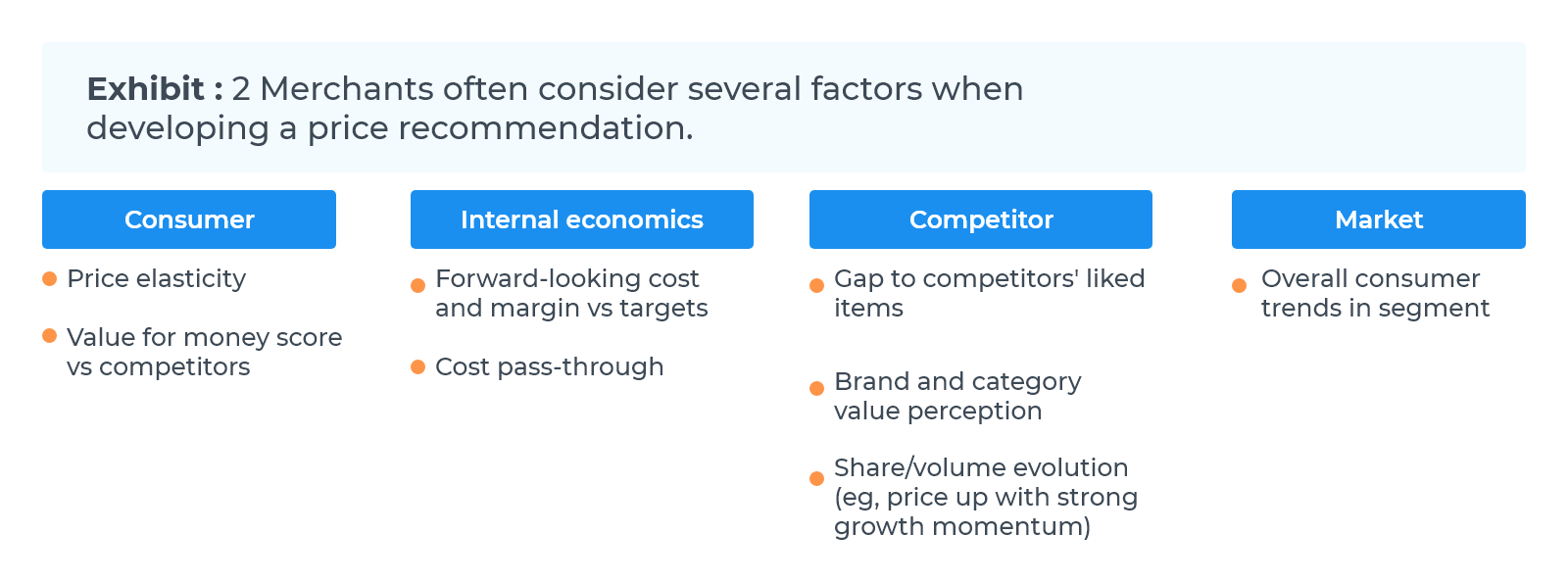

Get monthly notifications
Pricing strategies for eCommerce and retail companies
Working in retail today is challenging, and it’s never been harder to understand what the consumers are looking for. According to a study conducted by the NRF (National Retail Federation) almost 90% of the customers in the US are spending their money on discount retailers such as outlets and dollar stores. The most successful retailers today are the ones that use advanced statistical data combined with their intuition, to price their products.
As a performance marketer, you’re probably not in charge of pricing, but you have insights and access to data that is key in picking the right strategy for your company.
When a merchant is about to set a price on a new style or product, they usually need to take several factors into account. For instance,
- What will be the right initial price boost?
- How has a certain style performed lately?
- What price is needed to move inventory?
- How much do our competitors charge for a similar style?
A common problem is that merchants spend way too much time focusing on one single factor and therefore miss out on others. It’s also common that merchants don’t really know what’s bringing up sales. The most common problem is misconceptions about what impact a price change will have on sales or ROI from the Google Ads channel

New ways of pricing apparel
In the future, merchants will need to bring the same wisdom with them as they always have, like intuition, but also bring repeatable analytics to the table. Several inputs can be translated by retailers into a price recommendation for each style, which is valuable for merchants early on in their line planning. In this way, merchants get valuable insights from which they can set a price based on analytics for a style before they plan sales volumes and handle inventory. This means they have a much better idea of how much they actually will sell. A lot of this is information already available to the buyers and merchants, but apparel retailing is a complex market with ambiguous shopping patterns and constantly changing product assortments. The most difficult challenges within apparel pricing are -
1. New styles arriving every season
In apparel retail, a new season means new styles that usually don’t have connections to previous products. This means there is no long sales history to use as support. Here, AI can help merchants with these obstacles by using techniques like computer vision, text mining, and machine learning, which can identify groups of styles likely to respond in a similar way to changes in price and promotions. You have to be able to not only evaluate the average but also need to evaluate what price point makes your customer click and convert.
2. Never-ending promotions
Promotions are so commonly used these days that it’s become quite hard to determine a fair sales baseline. Offers like '20 percent off your whole purchase' is extremely common, and it’s therefore important for merchants to understand what ROI these offers bring. One successful way to isolate the impact of every promotion is to integrate new procedures into elasticity modeling. These aim to look for factors that might lower or grow sales results. A great way for merchants to make an estimate of the impact of their promotional plan is to leverage data from Google Ads to test and set optimal price points during campaigns.
3. Making inventory-purchasing decisions and early investments
If retailers apply analytical approaches, they can make better decisions when it comes to pre-season buying and pricing. They used to rely on intuition and trends but can now use these analytical approaches to get a clear picture of things like price changes and inventory levels. When you use this together with the smart approach of mapping new styles with last year's comparable styles, it can help you set the best initial ticket prices and inventory levels. Combining these 3 aspects will help you gather great inputs for your pricing strategy.
- Brand
- Category
- Product findings
4. Consumers expecting lower prices
Consumers expect lower apparel prices today since the competition has dramatically increased. But you can rarely compete in prices in every category. The smartest way of dealing with this issue is to apply a consumer-based view where you combine primary research with competitive price data. Start by identifying the categories in which the price is the most important to key customer segments. After that, choose a price that those customers will think is fair for those kinds of styles in that category.
5. Intricate optimization of price reductions
The greatest obstacle to creating new ways of price reductions is the way planners adopt new behaviours, not the intricacy of the optimization algorithm. Leading retailers use algorithms to optimize their different options for price reduction, such as a number of trade-offs inherent in the omnichannel model. The best way forward is to rank and prioritize scenarios to make it easy for planners to manage by exception, rather than going through every available consideration.

Conclusion
For smart pricing strategies, some important factors you need to be aware of are price elasticity, what prices the competitors have for similar styles and the role of a category in creating valued perceptions. This requires a total commitment to pricing analytics.
To be successful you need to use specialized tools that apply science to pricing and transform advanced analytics into simple insights and recommendations that buyers can use when they set pricing strategy. Don’t forget that it’s also important to have a user-friendly interface.
When you combine analytical pricing solutions with regular merchandising processes – and further add a change-management program – you will experience high adoption, mid-single-digit sales and margin increase. The recent trend of consumers comparing prices and leaning towards off-price retailers will only continue to grow, and promotions will continue to challenge merchants. But those apparel retailers who apply science to their regular pricing decisions will gain a powerful capability that can restore full-price selling.
A great starting point or an add-on to your pricing analysis and strategy is Google Ads. For this, Keywordio has developed the INSIGHT report where you will get insights about price points compared to your most relevant competitors and what actions to take. Read more about the INSIGHT report and what business intelligence will bring to you.
This is how you can grow your business using Google Ads - https://blog.keywordio.com/boost-your-e-commerce-sale-up-to-60-percent-by-using-google-shopping-ads'
Keywords: eCommerce, digital marketing, dynamic pricing, pricing strategy, price threshold, price sensitivity, price elasticity, Google Ads.
Sources:
McKinsey & Company: Powerful pricing: The next frontier in apparel and fashion advanced analytics https://drive.google.com/drive/folders/1rarB5btNy2AyAOrc8KLEJf2wsA8gRjiI
How to Implement eCommerce Price Elasticity to Your Online Store
Featured Articles
The Full Funnel Approach and Pinterest
Today, we're going to delve into the significance of working with a full-funnel strategy and understanding why a comprehensive media mix is crucial. We'll also explore an example of how this approach and including Pinterest in the media mix led to a significant decrease in the cost of sales for Houdini.
Master Text Overlays: Boost Ad Engagement
In recent years, capturing the attention of your target audience has become more challenging than ever. Businesses and marketers are constantly on the lookout for innovative ways to stand out in the crowded advertising landscape.
One effective technique to draw attention to your ad's message is through the use of text overlays on image and video ads. In this blog, we will explore the best practices for incorporating text overlays, ensuring your message is impactful without compromising the visual appeal of your ads.
Similar Articles
Exploring the Future of TikTok: Insights from the 2024 Trend Report
Introduction
I'm excited to delve into TikTok's comprehensive "What's Next 2024 Trend Report." This report is a treasure trove for anyone in digital marketing, offering deep insights into the future of content, storytelling, and consumer engagement on TikTok.
E-Commerce Excellence: Meta's Advantage+ Shopping Campaigns Redefined
Welcome to the dynamic world of e-commerce, where Meta's Advantage+ shopping is reshaping how businesses connect with customers. In this blog post, we'll explore the key features of this innovative tool.
Introducing TikTok Shop
Today, I bring to your attention a revolutionary update from TikTok, a platform where over 150 million Americans seek daily doses of inspiration and entertainment. With a plethora of trends, fashion hacks, beauty nuggets, and a smattering of recipes, TikTok has emerged as a modern-day oracle for curious minds. The excitement in the air thickens as we unveil TikTok Shop to the US, an avant-garde conduit for folks to spot and snag their adored items seamlessly.
The Full Funnel Approach and Pinterest
Today, we're going to delve into the significance of working with a full-funnel strategy and understanding why a comprehensive media mix is crucial. We'll also explore an example of how this approach and including Pinterest in the media mix led to a significant decrease in the cost of sales for Houdini.
Master Text Overlays: Boost Ad Engagement
In recent years, capturing the attention of your target audience has become more challenging than ever. Businesses and marketers are constantly on the lookout for innovative ways to stand out in the crowded advertising landscape.
One effective technique to draw attention to your ad's message is through the use of text overlays on image and video ads. In this blog, we will explore the best practices for incorporating text overlays, ensuring your message is impactful without compromising the visual appeal of your ads.
The Next Big Thing: 5 Digital Marketing Trends to Watch for in 2023
Digital marketing is a constantly evolving field, shaped by emerging technologies, changing consumer behaviors, and the dynamic nature of the online landscape. Staying on top of the latest trends is crucial for businesses and marketers to effectively engage with their target audience and drive growth. In this introduction, we will explore some of the key digital marketing trends that have emerged in recent times.
The Power of Branding on Meta
Are you ready to unlock unparalleled opportunities and take your online business to new heights? In a rapidly evolving digital landscape, Meta continues to revolutionize the way marketers and entrepreneurs create an impact on buyers.
Today, we will talk about the immense potential of branding on Meta's platforms, Facebook and Instagram based on our Meta Branding (Online Course). Brace yourself for insights that will empower you to establish a strong brand identity, harness consumer trends, and optimize your advertising strategies like never before! Ready to spearhead your business to success? by understanding the potential of branding on Meta and how you can tap into it. Excited? So are we - let's get into it!
A Sneak Peek into Pinterest's 2023 Product Updates!
Pinterest is improving its Ads Manager to provide a seamless experience for advertisers. New features will be released throughout 2023 to optimize advertising strategies. Pinterest aims to offer powerful tools and insights for better campaign results. Get a sneak peek into the exciting updates coming to Ads Manager this year.
Take Your TikTok Ads to the Next Level
To look into the future, let us peep into the past once. TikTok was once loaded with content focused on dancing and lip-syncing videos inclined more towards an uprising for polished platforms and enabling easy access and non-positionality of content largely consisting of short videos.